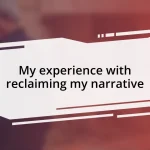Key takeaways:
- Flashbacks can be triggered by various stimuli, such as environmental cues, sounds, and anniversaries, highlighting the importance of recognizing personal triggers.
- Grounding techniques, like the 5-4-3-2-1 method and breathing exercises, can effectively help regain stability during flashbacks.
- Creating a safe space and establishing boundaries can significantly enhance emotional wellbeing and provide comfort during distressing moments.
- Seeking professional support offers tailored coping strategies and community, helping to validate and navigate experiences related to flashbacks.

Understanding Flashbacks
Flashbacks can be incredibly disorienting. I remember the first time I experienced one; I was suddenly pulled back to a moment that felt so vivid, as if it was happening all over again. It’s as if a time machine whisked me away, and I found myself reliving emotions that I thought I had processed long ago. Does that resonate with you?
These involuntary memories can be triggered by anything—from a specific smell to a sound that breaks through the present moment. For me, it was a song on the radio that transported me back to a difficult time in my life. The rush of feelings can be overwhelming, and I often find myself questioning, “Why is this happening now?” It’s a jarring experience, but understanding these triggers can empower us to navigate through them more smoothly.
While flashbacks are often associated with trauma, they can occur for various reasons. I’ve learned that they don’t diminish my strength; instead, they highlight the complexity of my experiences. What if, instead of feeling trapped by these memories, we viewed them as reminders of our resilience? Embracing this perspective has shifted how I cope with those vivid echoes from the past.

Recognizing Triggers and Patterns
Recognizing what triggers a flashback is crucial in managing them effectively. I often find myself reflecting on my past experiences, trying to identify patterns that precede these intense memories. For instance, certain places or conversations can evoke strong emotions tied to earlier events. The key is to remain attuned to these subtleties, as they can offer insight into what might trigger a flashback for me and potentially prepare me for when these moments arise.
Here are some common triggers I’ve noticed in my own journey:
- Environmental Cues: Specific locations or settings, like an old coffee shop, can bring back vivid memories.
- Sounds and Music: A melody or even a jingle can unexpectedly trigger emotional recollections.
- Social Interactions: Certain topics of discussion or even the tone of voice can open the floodgates to memories.
- Physical Sensations: Feeling a particular texture or temperature can sometimes lead me down memory lane.
- Anniversaries: Dates connected to significant events often provide a reminder that can set off a flashback.
The more I explored these connections, the closer I came to understanding myself and my reactions. It’s as if each trigger reveals another layer of my emotional landscape, helping me navigate through the complexities of my experiences with greater awareness and intentionality.

Grounding Techniques for Stability
Grounding techniques serve as vital tools for regaining stability during flashbacks. They’ve played a pivotal role in my journey. One technique that I find particularly effective is the 5-4-3-2-1 method, where I engage my senses to anchor myself in the present. For example, I’ll identify five things I can see around me, four things I can touch, three sounds I can hear, two smells, and one taste. This practice not only brings me back to the here and now but also reminds me that I am safe and in control. Have you ever tried something similar? It can truly transform your experience during those disorienting moments.
Another grounding technique I often use is focusing on my breath. When I feel a flashback creeping in, I deliberately slow my breathing, inhaling deeply and exhaling slowly. This rhythmic pattern helps quiet my racing thoughts. I can often visualize my breath as a wave, crashing in and receding, much like those memories. It’s fascinating how something as simple as breath can create such a profound sense of peace. Have you considered how your breath could serve as a bridge to calmness during tumultuous times?
Lastly, I find comfort in tactile grounding objects, like a stress ball or a piece of textured fabric. Holding something tangible can create a shift in my awareness. I once carried a smooth stone from a beach that reminded me of happier times. Whenever I felt a flashback approaching, squeezing that stone helped pull my focus away from the vivid, distressing memories and placed me firmly in the present. What physical items could you keep close by that evoke positivity for you? The power of these simple strategies shouldn’t be underestimated; they can provide an anchor when the storms of memory arise.
| Grounding Technique | Description |
|---|---|
| 5-4-3-2-1 Method | A sensory awareness exercise that involves identifying five things you see, four you can touch, three sounds you hear, two smells, and one taste to reconnect with the present. |
| Breathing Exercises | Focused breathing that uses slow, controlled inhalations and exhalations to calm the mind and body, grounding you in the moment. |
| Tactile Objects | Physical items, such as stress balls or textured fabrics, that provide comfort and help shift focus away from distressing memories. |

Creating a Safe Space
Creating a safe space is essential for managing flashbacks effectively. I remember a time when I transformed a small corner of my bedroom into a sanctuary. I filled it with soft pillows, calming colors, and cherished photographs that brought me peace. Each time I sat there, I felt my tension fade, as if that space was cocooning me in a protective bubble. Have you ever made a specific area feel like a refuge? It can make all the difference.
Establishing boundaries within that space is just as important. I’ve learned to communicate with friends and family about my need for solitude when the memories surface. When someone respects that boundary, it reassures me that I’m in control of my environment. I often ask myself how far I’m willing to go to protect my mental health, and the answer is always: as far as I need. What boundaries do you think you could set to create your own safe haven?
Lastly, incorporating sensory elements can enhance the feeling of safety. I love lighting scented candles that remind me of my grandmother’s kitchen, filling the air with baking spices. The warmth of the aroma brings back comforting memories, grounding me in positivity. I invite you to consider what scents, sounds, or textures evoke a sense of calm for you. It’s these small details that can manifest a safe space, allowing you to step outside the chaos of flashbacks and find solace in the present moment.

Developing a Coping Strategy
Developing a coping strategy requires self-awareness and experimentation. For me, journaling has been a critical outlet. On days when flashbacks feel overwhelming, I pour my thoughts into pages, articulating the emotions and sensations that arise. I often wonder, how do my experiences shape my understanding of these moments? Writing helps me map those feelings, solidifying a sense of clarity and purpose.
Another strategy I have found effective is creating a playlist of songs that uplift my mood. Music has an extraordinary ability to shift our emotional landscape, don’t you think? When a flashback looms, I turn to these melodies to guide my thoughts elsewhere. I remember one instance when a particular song instantly took me back to a joyful summer night with friends. That connection reminded me of the beauty in life, drawing me away from the heaviness of the past.
Lastly, I can’t stress enough the impact of reaching out for support. I’ve learned that sharing my experiences with a trusted friend can provide an incredible boost. There have been times when just vocalizing how I feel relieved the weight on my shoulders. Have you considered who in your life you can confide in when those memories return? Finding someone who understands can make a profound difference, reminding you that you’re not alone in this journey.

Seeking Professional Support
Reaching out for professional support was one of the hardest steps I took, but it turned out to be a game-changer. I vividly recall my first therapy session, sitting nervously in the waiting room, contemplating whether I’d truly find someone who understood my struggles. But once I began sharing my experiences with a compassionate therapist, it felt as if a weight was lifted. Have you ever felt that sense of liberation when someone finally gets you? It’s incredible.
Finding the right professional can take time, and I learned that it’s okay to explore different options. I remember attending a support group for individuals facing similar challenges. Listening to others share their journeys was cathartic; it made me realize I wasn’t alone. Have you thought about joining a group where you can find shared understanding? The camaraderie and validation can be a balm for the soul.
What truly resonated with me was the tailored coping strategies a professional can provide. My therapist guided me through grounding techniques, like focusing on my breathing or engaging my senses to anchor myself during a flashback. It might sound simple, but having a toolkit in those moments made me feel empowered. How do you feel about the idea of having specific tools at your disposal when the past tries to creep in? It’s an invaluable resource that can transform your approach to healing.

Maintaining Long-Term Wellbeing
Maintaining long-term wellbeing is a journey that requires ongoing effort and self-care. I’ve found that establishing a daily routine can make a significant difference. It’s those little, consistent practices—like a morning meditation session or a brisk walk in the fresh air—that have become anchors in my life. Have you ever noticed how a structured day can provide a sense of security amidst chaos?
It’s also essential to cultivate an environment that supports my mental health. I remember rearranging my living space one afternoon, intentionally creating a calming atmosphere with soft lighting and comforting elements. This act transformed the room into a sanctuary—a place where I can retreat when life feels heavy. What changes could you make in your space that would help you cultivate a peaceful mindset?
Another key component I’ve embraced is the importance of self-compassion. There are days when I catch myself spiraling into negative self-talk, but I’ve learned to acknowledge those feelings without judgment. Instead of criticizing myself for struggling, I remind myself that it’s okay to feel this way. How often do we forget to show kindness to ourselves during tough times? Giving myself permission to feel and heal has become vital in my long-term wellbeing strategy.














